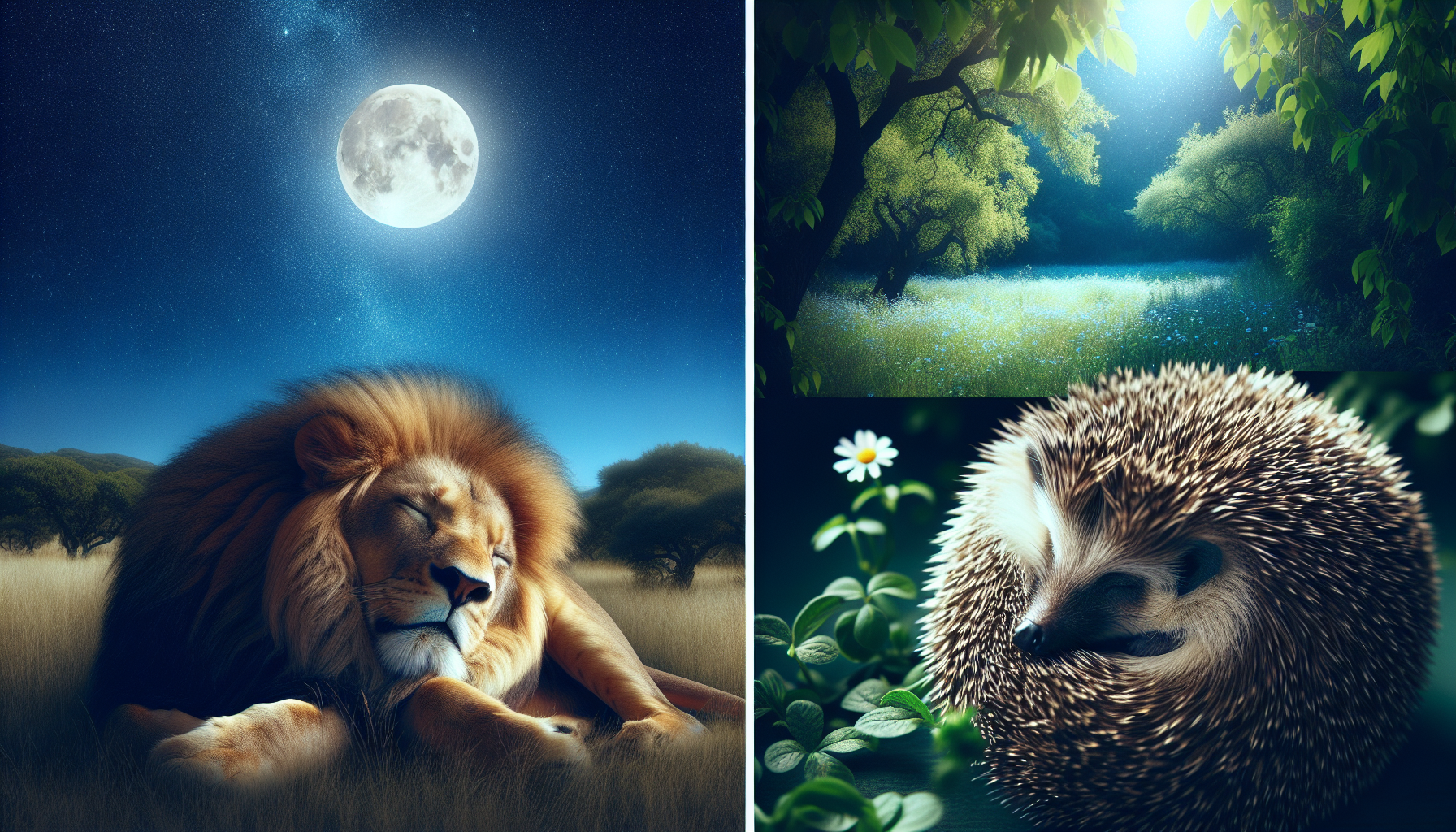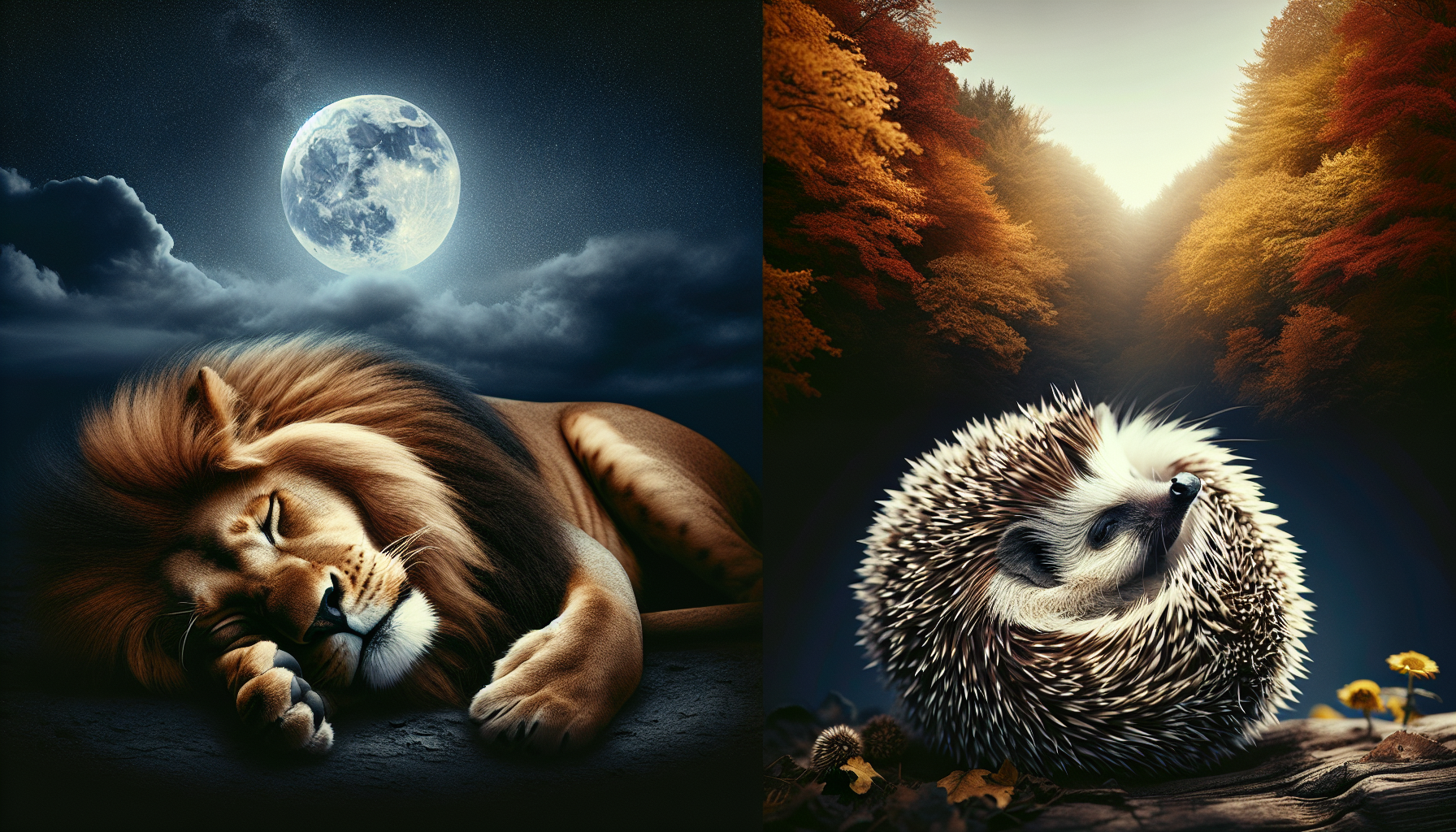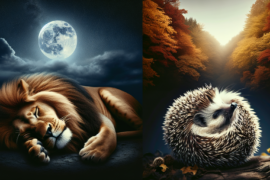Have you ever wondered why different animals sleep in different ways? If so, then you’re in the right place! In this fascinating article, we’ll take you on a journey through the intricate world of animal sleeping patterns. From the long naps of sloths to the power naps of dolphins, we’ll explore the diverse ways in which creatures rest and rejuvenate. So, sit back, relax, and let’s embark on a step-by-step guide to understanding animal sleeping patterns.
Sleeping Patterns in Animals
Circadian Rhythms
Circadian rhythms refer to the natural, internal processes that regulate the sleep-wake cycles in animals. These rhythms are driven by biological clocks, which are found in most organisms, including plants and animals. Circadian rhythms follow a 24-hour cycle and are influenced by external factors such as light and temperature. In animals, these rhythms determine whether they are diurnal (active during the day) or nocturnal (active during the night).
Nocturnal Animals
Nocturnal animals are those that are primarily active during the night and sleep during the day. These animals have adapted to low-light conditions and have specialized sensory organs that allow them to navigate and hunt in the dark. Examples of nocturnal animals include owls, bats, and most species of rodents. Their sleeping patterns are naturally aligned with their active period, allowing them to optimize their survival strategies.
Diurnal Animals
Diurnal animals, on the other hand, are active during the day and sleep at night. These animals have well-developed eyesight and rely on sunlight for various activities, such as foraging for food and social interactions. Examples of diurnal animals include most bird species, many primates, and some reptiles. Their sleeping patterns are closely tied to the availability of light and are adapted to maximize their efficiency during daylight hours.
Factors Affecting Animal Sleeping Patterns
Evolutionary Adaptations
Animals have evolved different sleeping patterns based on their ecological niche and lifestyle. Evolutionary adaptations have shaped the sleep patterns of animals to optimize their survival and reproductive success. For example, predatory animals may have shorter sleep cycles to increase their hunting opportunities, while prey animals often have longer sleep durations to conserve energy and remain vigilant for potential threats.
Environmental Factors
Environmental factors, such as temperature, humidity, and noise levels, can significantly influence animal sleeping patterns. Some animals, like polar bears and certain amphibians, may adjust their sleep patterns according to seasonal changes in their environment. High temperatures can also disrupt sleep in animals, leading to adaptations such as burrowing or seeking shade during the day to avoid excessive heat.
Predator-Avoidance Strategies
Sleep is a vulnerable state for animals, as it decreases their ability to respond to predators or other threats. As a result, many animals have developed various predator-avoidance strategies during sleep. Some animals, like dolphins and seals, exhibit unihemispheric sleep, where only one hemisphere of the brain sleeps at a time, allowing them to remain partially aware of their surroundings. Others may sleep in groups or adopt specific sleeping positions that offer protection and increase their chances of detecting potential dangers.

Types of Animal Sleep
Non-REM Sleep
Non-REM (rapid eye movement) sleep is characterized by the absence of rapid eye movements and is often associated with deep sleep. During this stage, animals experience reduced muscle activity and decreased awareness of their surroundings. Non-REM sleep is essential for rest and recovery and is often accompanied by physiological processes such as tissue repair and growth hormone release. Many animals, including humans, spend a significant portion of their sleep time in non-REM sleep.
REM Sleep
REM sleep is a unique stage of sleep characterized by rapid eye movements and increased brain activity. This stage is associated with dreaming and cognitive functions, as well as the consolidation of memories. Certain animal species, such as mammals and birds, exhibit REM sleep. For example, dogs often twitch or whimper during REM sleep, suggesting their involvement in vivid dreaming experiences.
Unihemispheric Sleep
Unihemispheric sleep is a rare sleep pattern observed in some animals, particularly aquatic mammals and birds. It involves the ability to sleep with one hemisphere of the brain while the other remains awake and alert. This adaptation allows animals to engage in activities such as swimming or flying while still being partially asleep. Unihemispheric sleep is crucial for maintaining essential functions like breathing and vigilance in environments where predators may be present.
Sleep Duration in Animals
Short Sleepers
Some animals are known as short sleepers because they require only a minimal amount of sleep. These animals, such as horses and elephants, have evolved mechanisms to reduce their sleep time without compromising their well-being. Short sleepers often have complex sleep cycles that involve brief periods of sleep followed by longer periods of wakefulness. They are capable of entering deep sleep quickly and may take short naps throughout the day.
Moderate Sleepers
Moderate sleepers, like humans and many other mammals, require an average amount of sleep each day. These animals typically exhibit a regular sleep-wake cycle, with distinct periods of sleep and wakefulness. They rely on both non-REM and REM sleep for various physiological and cognitive functions. Moderate sleepers often have sleep durations that range from several hours to around half of each 24-hour period.
Long Sleepers
Long sleepers, such as certain bat species and sloths, have relatively long sleep durations compared to other animals. These animals may spend up to 20 hours or more in a state of sleep or rest. The extended sleep duration allows them to conserve energy and adapt to their specialized lifestyles. Long sleepers often have slower metabolic rates and may exhibit adaptations, such as hanging upside down, to optimize their sleeping positions.

Unique Sleeping Behaviors in Animals
Hibernation
Hibernation is a unique sleeping behavior observed in many mammals, particularly those in cold climates. During hibernation, animals enter a state of prolonged sleep with significantly reduced metabolic rates and heart rates. They rely on stored fat reserves to sustain them throughout the winter when food is scarce. Hibernating animals, such as bears and ground squirrels, may spend several months in a dormant state until the weather conditions improve.
Estivation
Estivation is a form of dormancy similar to hibernation but occurs in response to hot and dry conditions. Animals that estivate, like certain species of reptiles and amphibians, enter a state of reduced activity and high metabolic suppression. Estivation allows these animals to conserve water and energy in arid environments. They may bury themselves in the ground or seek sheltered areas to escape the heat and reduce water loss.
Torpor
Torpor is a temporary state of reduced activity and metabolic depression observed in various animals. Unlike hibernation or estivation, torpor is of shorter duration and occurs in response to environmental factors such as temperature fluctuations or food scarcity. Torpor helps animals conserve energy by lowering their metabolic rates, breathing rates, and body temperatures. Hummingbirds, for example, enter torpor during the night to conserve energy due to their high metabolic demands.
Sleep Positions in Animals
Prone Position
The prone position is commonly observed in animals that sleep on their stomachs or bellies. This sleep position maximizes heat conservation, especially in animals that live in colder climates. Examples of animals that adopt the prone position include dogs, cats, and bears. Sleeping in this position allows these animals to maintain warmth and protect their vital organs.
Supine Position
The supine position refers to animals that sleep on their backs with their bellies exposed. This position is commonly seen in animals that feel secure in their environment and do not perceive any immediate threats. It is often observed in highly social species, such as primates, that rely on group members for protection and vigilance during sleep.
Curling Up
Curling up is a common sleep position observed in many animals, especially those with a flexible body structure. This position involves tucking the head and limbs close to the body, providing protection and minimizing heat loss. Many mammals, including dogs and cats, naturally adopt this position to conserve warmth and create a sense of security during sleep.
Sleep Cycles in Animals
Ultradian Rhythm
The ultradian rhythm refers to shorter sleep cycles that occur within the larger circadian rhythm. Many animals, including humans, experience multiple ultradian cycles during a 24-hour period. These cycles consist of alternating periods of sleep and wakefulness, typically lasting around 90-120 minutes. Ultradian rhythms play a crucial role in facilitating various cognitive processes, including memory consolidation and learning.
Polynesian Sleep
Polynesian sleep is a sleep pattern observed in certain bird species, particularly those that engage in long-distance migratory flights. Birds that exhibit polynesian sleep can sleep while in flight, allowing them to rest and conserve energy during their journeys. This unique adaptation enables these birds to maintain their vital functions and continue their migrations without interrupting their sleep cycles.
Bimodal Sleep
Bimodal sleep is a sleep pattern observed in some animal species, including certain primates. It involves splitting the sleep period into two distinct phases, often with a wakefulness period in between. This adaptation allows animals to optimize their activity patterns and fulfill their ecological requirements. Primates, for instance, may have a longer sleep period during the night and a shorter sleep period during the day.
Sleep Patterns Across Animal Species
Mammals
Sleep patterns in mammals can vary significantly across different species. Some mammals, like bats and rodents, are nocturnal and sleep during the day, while others, such as humans and primates, are diurnal and sleep at night. However, exceptions exist, such as certain marine mammals that exhibit unihemispheric sleep. Mammals exhibit a wide range of sleep durations, sleeping positions, and unique sleep behaviors, making the study of their sleep patterns both fascinating and diverse.
Birds
Birds are known for their unique sleep patterns and behaviors. Many bird species are diurnal and sleep during the night, while others engage in polynesian sleep during migration. Birds often exhibit unihemispheric sleep, allowing them to remain partially awake for essential functions like flight and predator detection. Certain bird species, such as the albatross, have even been observed flying in their sleep, showcasing the remarkable adaptations they possess.
Reptiles
Reptiles have diverse sleep patterns that differ from mammals and birds due to their distinct physiological characteristics. Most reptiles are ectothermic, relying on environmental heat sources to regulate their body temperature. As a result, reptiles often exhibit sleep behaviors tied to thermoregulation, such as basking in the sun during the day and seeking sheltered areas at night. While reptiles do experience sleep, their sleep patterns and duration differ between species.
Fish
Although fish may not exhibit sleep patterns that resemble those of mammals or birds, they do have periods of rest and inactivity. Fish are continuously exposed to their watery environment, making traditional sleep cycles challenging to observe. Instead, fish display periods of reduced activity and slower metabolic rates, allowing them to rest and conserve energy. Fish sleep behaviors vary between species and can include reduced swimming, decreased responsiveness, and changes in body posture.
Sleep in Domesticated Animals
Cats
Cats, as domesticated animals, exhibit unique sleep patterns that reflect both their ancestral traits and their adaptation to the domestic environment. Cats are crepuscular animals, meaning they are most active during dawn and dusk and sleep for longer durations during the day and night. They follow a polyphasic sleep pattern, breaking their sleep into several short naps throughout the day. Cats also possess the ability to sleep lightly, allowing them to be responsive to any potential threats while still resting.
Dogs
Dogs, as domesticated animals and descendants of wolves, have sleep patterns influenced by their evolutionary history and their close relationship with humans. Dogs are highly adaptable sleepers and can adjust their sleep patterns to match their owner’s routines. They are also social sleepers and often prefer to sleep near their human companions or other dogs. Dogs typically exhibit monophasic sleep patterns, characterized by longer sleep durations at night, interrupted by shorter periods of wakefulness throughout the day.
Horses
Horses, both wild and domesticated, have unique sleep patterns influenced by their evolutionary adaptations as prey animals. Horses are polyphasic sleepers and can sleep both standing up and lying down. They often exhibit unihemispheric sleep, allowing them to remain partially vigilant while resting. Horses also have the ability to enter REM sleep while standing, a trait that enhances their survival instincts in the face of potential threats.
The Importance of Understanding Animal Sleeping Patterns
Conservation Efforts
Understanding animal sleeping patterns is crucial for effective conservation efforts. By studying the sleep behaviors of endangered or threatened species, researchers can gain insights into their ecological requirements and develop conservation strategies. For instance, understanding the sleep patterns of migratory bird species helps identify critical resting areas along their routes, enabling the establishment of protected areas to support their survival.
Behavioral Studies
The study of animal sleeping patterns provides valuable information about their behavior and cognition. Sleep is closely linked to various cognitive functions, including memory consolidation, learning, and problem-solving. By observing the sleep patterns of animals, researchers can gain insights into their cognitive abilities and understand how sleep influences their overall behavior and cognitive performance.
Animal Welfare
Understanding animal sleeping patterns is essential for ensuring their wellbeing and meeting their physiological needs in captivity or domestic settings. By providing animals with appropriate sleep environments, including proper lighting, temperature, and resting surfaces, we can promote healthy sleep patterns and improve their overall quality of life. Knowledge of animal sleep patterns also helps in the development of ethically responsible practices in animal husbandry and veterinary care.
In conclusion, animal sleeping patterns are diverse and influenced by various factors, including evolutionary adaptations, environmental conditions, and predator-avoidance strategies. Animals exhibit different sleep durations, positions, and sleep cycles, all of which have evolved to optimize their survival and reproduction. By studying these patterns across different animal species, we can gain a deeper understanding of their behaviors, cognitive abilities, and ecological requirements. Understanding animal sleep patterns is not only fascinating but also crucial for conservation efforts, behavioral studies, and ensuring animal welfare in various settings.
